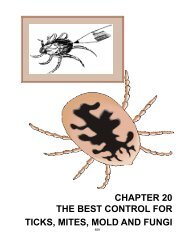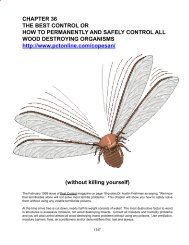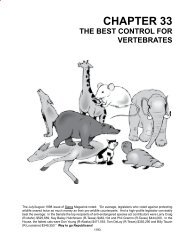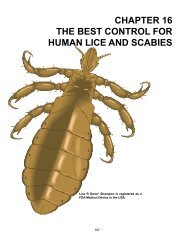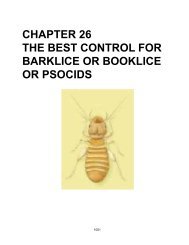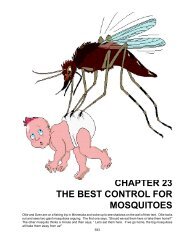for children who are otherwise healthy. However, an analysis of the National Maternal and Infant Health Survey,published in the journal Pediatrics in 1997, found that 54 percent of parents of preschool children gave them avitamin or mineral supplement at least three days a week.Advocates of the products correctly point out that the poison centers’ figures do not prove a causal link betweena product and a reaction and that, in any case, far more people are injured and killed by drugs. Painkillers alonewere associated with 283,253 exposures in 2005, according to the poison centers, more than twice as many aswith supplements. But only 3.5 percent of those exposures occurred when people took the prescribed amountof painkiller; most were from overdoses, either accidental or intentional. <strong>The</strong> same was true of asthma drugs(3.6 percent of exposures were associated with the prescribed dose) and cough and cold drugs (3.1 percent).While problems with vitamins, minerals and essential oils occurred at similarly low levels when people took therecommended amounts, exposures linked to the recommended levels of herbs, homeopathic products andother dietary supplements accounted for 10.3 percent of all exposures to those products reported to the poisoncenters — about three times the level seen for most drugs.Drugs marketed in the U.S. go through a rigorous F.D.A. approval process to prove that they are effective for aparticular indication, with the potential risks balanced against the benefits. While the approval process has comeunder attack in recent years as unduly favorable to drug companies, it remains among the toughest in the world.<strong>The</strong>re is no comparable requirement for supplements. Even so, hundreds of millions of tax dollars have beenspent since the early 1990s on hundreds of studies to test the possible benefits of supplements. <strong>The</strong> NationalCenter for Complementary and Alternative Medicine, established by Congress in 1991 to “investigate and validateunconventional medical practices,” has a 2007 budget of more than $120 million.Since April 2002, five large randomized trials financed by the center have found no significant benefit for St.John’s wort against major depression, echinacea against the common cold, saw palmetto for enlarged prostate,the combination of glucosamine and chondroitin for arthritis, or black cohosh and other herbs for the hot flashesassociated with menopause.A new source of data on exposures to dietary supplements will soon become available: in December, Congresspassed a measure requiring the manufacturers of dietary supplements and over-the-counter drugs to inform theF.D.A. whenever consumers call them with reports of serious adverse events. <strong>The</strong> bill was signed by PresidentBush the day after Christmas. It is a welcome acknowledgment that “natural” does not always mean “safe.”<strong>The</strong> supplements linked to the most reactions in 2005, according to the poison control centers, were ordinaryvitamins, accounting for nearly half of all the reports received that year, 62,446, including 1 death. Minerals werelinked to about half as many total reports, 32,098, but that number included 13 deaths. Herbs and other specialtyproducts accounted for still fewer total reports, 23,769, but 13 deaths. Essential oils were linked to 7,282 reportsand no deaths. Always test a small area before you treat the entire area and always test a small amount beforeyou ingest or apply larger amounts. It is known some people are allergic to peanuts and milk. As a generalrule, pregnant women should avoid contact with herbs.Herbal Tea Sprays - After preparing the following plants in a water solution:Burdock - Has been used against June beetle grubs.Camomile - Against damping-off in greenhouses and cold frames.Cayenne Pepper - Against caterpillars and fleas.Chive - Against leaf and fruit scab.Elderberry Leaves - <strong>Control</strong>s blight, caterpillars and flea beetles.Garlic and Onion - Against late blight on tomato and potato and brown rot of stone fruit; red spidersand aphids. This mix is also a powerful antibacterial product that destroys many plant diseases.Gooseberry - Against mildew.Horseradish - Against fungi.Horsetail (Equisetum arvense) - Against mildew and other fungi, especially on grapevines, vegetables,fruit trees and rose bushes.Hyssop - Against bacterial diseases.Pumpkin or Squash Leaves, Freshly Cut, a decotion of black walnut leaves soaked overnight or an402
infusion of pignut leaves, rubbed on horses or cattle will repel fliesRhubarb - Against club root, greenfly and blackspot.Stinging Nettle - Against plant lice (aphids).Tomato Leaves - Against aphids, grasshoppers, caterpillars and flies.Wormwood - Against leaf-eating caterpillars on fruit trees and aphids.NOTE: Many herbs, through their essential oils, have natural insecticidal, fungicidal andbactericidal properties.Herbivorous Fish - Julien (1992) lists eleven species of fish that have been introduced for the biological controlof water weeds and algae.Herbs/Herbal Pillows - can be used to repel flies, fleas, mice, roaches and many other pests. Horsebalm,cardamon, tea tree, spearmint, rosemary, eucalyptus and sage are herbs that can and do naturally inhibitcholinesterases in mammals, so be very careful.Heterorhabditis bacteriophora (HP 88): Among the most important beneficial nematodes, H. bacteriophoraattack insect larvae especially root weevils. This “cruiser” specie is less effective in cooler temperatures, souse above 20 degrees C. <strong>The</strong> main beneficial nematodes are Steinernema carpocapsae and Heterorhabditisbacteriophora. If you have these two handy to spread on your property then most of the harmful insects will betaken care of. However, there are others that seem to specialize as to insects they parasitize. Although thereis a right beneficial nematode for that varmit you want out of your lawn and garden, there is not a way right nowto get them all commerically.High Places - German cockroaches like high places, so put your baits on top of kitchen cabinets.Hike or walk - around the exterior and inspect the vents, weep holes, seals, screens, doors, caulking, siding,gutters, downspouts, exterior and ground and pretend you are a pest trying to invade the structure.Hoes - A very ancient and extremely effective way to remove weeds from your garden or yard.Hollow Tubes - Paint 1-foot long hollow tubes, straws or bamboo green and place them side by side under lowgrowing shrubs and bushes to catch earwigs, cutworms and other pests. In the morning, empty the tubes intosoapy water.Home-made “Pesticides” - Make your own by blending ½ cup hot peppers and/or garlic with 2 cups waterand spraying it on infested plants; another mix could be 1 cup enzyme cleaners in water or 2 teaspoons of dishwashing liquid with a few drops of vegetable oil in 1 gallon of water; or use a blender and blend 1 quart of water,2 - 4 hot peppers and 3 - 5 cloves of garlic, blend, strain and spray on plants - thoroughly wash vegetablesbefore eating. See also mint, soap, rhubarb, stinging nettle, baking soda, buttermilk, vinegar and plain water.We prefer to call these mixes Pestisafes ® .Honey Remedy for Skin Blemishes - Cover the blemish with a dab of honey and place a Band-Aid over it.Honey kills the bacteria, keeps the skin sterile and speeds healing. Works overnight. Honey has been shownto have an anti-microbial effect against many bacteria and fungi and will attract most sweet eaters to your baits/traps. Honey does not spoil because there is so much sugar in it that bacteria cannot grow. Use it to help heal awound or to make irresistable baits. Honey will heal infected wounds and is effective against antibiotic-resistantbacteria. Honey releases low levels of hydrogen peroxide and some honeys have an additional phytochemical,anti-bacterial component. Honey has been an ancient remedy for treating infested wounds. When diluted bywater or wound exudate, honey contains an enzyme that now produces hydrogen peroxide. Honey will also helpheal burns; sugar does not work as well. Staphyloccus aureus wounds are quickly rendered sterile. Allergicreactions to honey are attributed to a reaction to a specific pollen in some honeys.Honor - For honorable human beings, doing what is right and necessary is dearer than life itself. “What is notdone for love is done for money.” Psalm 55:12-16Hopperdozer - consists of a long, narrow, shallow trough filled with soapy water with a vertical shield at the403
- Page 1: CHAPTER 11SAFE AND FAR MOREEFFECTIV
- Page 4 and 5: pesticide poisons do - to them the
- Page 6 and 7: American Beautyberry (Callicarpa am
- Page 8 and 9: packets in 4 days or less. Aspartam
- Page 10 and 11: Baking Soda - Baking soda or sodium
- Page 13 and 14: Bioderivatives - are substances whi
- Page 15 and 16: Bird feeders - will attract more th
- Page 17 and 18: an abrasive action on the insect wh
- Page 19 and 20: pathogens - volatiles produced duri
- Page 21 and 22: ground, grain and stored product ap
- Page 23 and 24: epels many insects, including flies
- Page 25 and 26: een used medically since at least t
- Page 27 and 28: Collateral Damage - When you spray
- Page 29 and 30: Cottonseed Meal - is a source of ni
- Page 31 and 32: Desiccants - Hot air, dehumidifiers
- Page 33 and 34: Dogs - have been trained to sniff o
- Page 35 and 36: elderberry leaves to protect them f
- Page 37 and 38: controls pests and acts as a deodor
- Page 39 and 40: contamination that no one can hones
- Page 41 and 42: Chlorphyll Graphite Parrafin wax Wa
- Page 43 and 44: Film Capsule - The plastic capsule
- Page 45 and 46: Repel roaches with bay leaves and e
- Page 47 and 48: person in your house, but you’ll
- Page 49 and 50: slender sickle-shaped jaws. They ap
- Page 51: epellent that contains only natural
- Page 55 and 56: Human Hair - cut in small pieces wi
- Page 57 and 58: Insect Diseases - In 1836, Agostino
- Page 59 and 60: Irrigation Management - Improper ir
- Page 61 and 62: lack cutworms.Laxatives - Chocolate
- Page 63 and 64: we die. Check out magnesium in Chap
- Page 65 and 66: Milk Thistle - is a proven detoxifi
- Page 67 and 68: Moon Flower (Datura ioxia) - Do not
- Page 69 and 70: Spotted knapweed begins producing c
- Page 71 and 72: Nothing - Doing nothing is a choice
- Page 73 and 74: fertilizers and sprays will normall
- Page 75 and 76: added to enzyme cleaners or when us
- Page 77 and 78: yellow to yellow crystalline solid
- Page 79 and 80: Aureolaria virginica (L.) Pennell.
- Page 81 and 82: Clematis vitalba L. (Honduras fish
- Page 83 and 84: Euphorbia bicolor Engelm. and Gray.
- Page 85 and 86: Justicia adhatoda L. (Adhatoda vasi
- Page 87 and 88: Momordica charantis L. (Balsam-pear
- Page 89 and 90: Piper nigrum L. (Black pepper).Stro
- Page 91 and 92: Sesamum indicum L. (S. orientale L.
- Page 93 and 94: Xanthorrhoea hastilis R. Br. (Black
- Page 95 and 96: Pomander - Repel moths and other in
- Page 97 and 98: y Safe Solutions at 1-888-443-8738
- Page 99 and 100: ight red and cover them with petrol
- Page 101 and 102: a wide variety of antioxidants call
- Page 103 and 104:
Sawdust - Sawdust can be treated wi
- Page 105 and 106:
lit charcoal in the tunnels would a
- Page 107 and 108:
Active IngredientGeneric Name Trade
- Page 109 and 110:
Sour Milk - sprays will loosen scal
- Page 111 and 112:
Stay Calm - Take a deep breath amd
- Page 113 and 114:
to make the mix about the consisten
- Page 115 and 116:
pesticides have never controlled or
- Page 117:
Temperature - Increase or lower tem
- Page 120 and 121:
in colder climates. The most fragra
- Page 122 and 123:
and/or dehumidifiers, plumbing and
- Page 124 and 125:
odents, scorpions, etc. to your bai
- Page 126 and 127:
Oregano also contains four anti-ast
- Page 128 and 129:
like colds, and headaches and spend
- Page 130 and 131:
then estimated human population. Gi
- Page 132 and 133:
“The choice, after all, is ours t
- Page 134:
484



